Appearance and Design
The design and styling of the w2207 is clearly intended to make it stand out from the crowd. Whether or not that's a good thing depends on your own personal preference. For better or for worse, the w2207 comes with a glossy mirror-like finish that can serve as a magnet for fingerprints and dust. If you have grubby fingers - or others in your house that do - you may find yourself spending an inordinate amount of time wiping down the exterior of this display.
The front of the LCD is a combination of glossy black for the border around the panel, while the stand is silver with a rough texture. At the bottom right of the LCD, we get the usual buttons for accessing the on-screen display (OSD). The left button brings up the OSD, at which point all four buttons can be used to navigate the menus. Prior to entering the menu, the right button can be used to execute the auto adjustment function (for use with analog connections), the second button brings up volume control, and the third button cycles between five display modes (movie, photos, games, text, and user defined). The power button, incidentally, is located on the top of the chassis and glows a faint orange/blue depending on whether the display is powered on or in standby mode.
As mentioned already, you can pivot the display into portrait mode, which some people find useful for reading long web pages or documents. You will need to raise the LCD before pivoting as well as tilting the panel back a bit, and afterwards there were only be an inch or two of vertical travel available.
The back of the display is primarily composed of black plastic, again with a rough texture. Ventilation slots can be seen around the border, and you can also get a better view of the base stand. The main panel sits on a cantilevered arm that ends up making the display quite a bit deeper than it would otherwise need to be. The main panel can also be laid flat against the base stand, which is how the unit is shipped, though it doesn't seem practical to try using the LCD in that position.
The expected input ports are all present on the rear of the display, facing downwards. DVI and VGA inputs are available, a USB input is located at the far right, and in the center is an audio jack. Nearly all of the necessary cables are included, although it wasn't clear whether a DVI cable comes with the LCD or not. Our unit arrived without a DVI cable, and considering that's our preferred connection for LCDs we would certainly like to see a DVI cable rather than a VGA cable included - and ideally both of them. The included speakers, incidentally, are all but useless. Even in a quiet room, it is difficult to hear audio through them, and the quality of audio they can provide is lacking at best.
Looking at the profile of the LCD, we see the range of motion that the base stand offers. Two USB ports are located on the left side, while the right side is empty. You can also see how the base stand extends several inches behind the back of the display.
One of the features that HP advertises with the w2207 is their Easy Clip accessory kit that can be used to hold papers, pens, or other useful bits of information. We did not get the accessory kit with our review unit, but they did send us a webcam that attaches to the top of the display. The webcam we received is not the same model that we see shown on the online ordering pages, so we're not sure how much it actually costs. We can say that it functioned pretty much as you would expect from a webcam, and if you're the type of person that likes to use such a device the ability to easily connect it to the top of your display might make the addition worthwhile. If you don't plan on using the webcam, of course, save your pennies!
The design and styling of the w2207 is clearly intended to make it stand out from the crowd. Whether or not that's a good thing depends on your own personal preference. For better or for worse, the w2207 comes with a glossy mirror-like finish that can serve as a magnet for fingerprints and dust. If you have grubby fingers - or others in your house that do - you may find yourself spending an inordinate amount of time wiping down the exterior of this display.
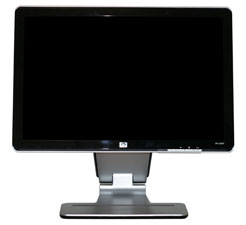 |
 |
The front of the LCD is a combination of glossy black for the border around the panel, while the stand is silver with a rough texture. At the bottom right of the LCD, we get the usual buttons for accessing the on-screen display (OSD). The left button brings up the OSD, at which point all four buttons can be used to navigate the menus. Prior to entering the menu, the right button can be used to execute the auto adjustment function (for use with analog connections), the second button brings up volume control, and the third button cycles between five display modes (movie, photos, games, text, and user defined). The power button, incidentally, is located on the top of the chassis and glows a faint orange/blue depending on whether the display is powered on or in standby mode.
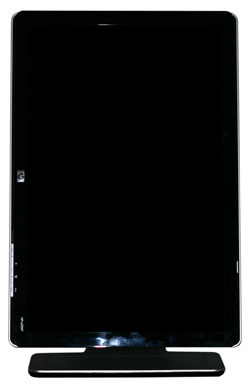 |
As mentioned already, you can pivot the display into portrait mode, which some people find useful for reading long web pages or documents. You will need to raise the LCD before pivoting as well as tilting the panel back a bit, and afterwards there were only be an inch or two of vertical travel available.
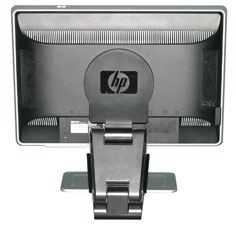 |
 |
The back of the display is primarily composed of black plastic, again with a rough texture. Ventilation slots can be seen around the border, and you can also get a better view of the base stand. The main panel sits on a cantilevered arm that ends up making the display quite a bit deeper than it would otherwise need to be. The main panel can also be laid flat against the base stand, which is how the unit is shipped, though it doesn't seem practical to try using the LCD in that position.
 |
The expected input ports are all present on the rear of the display, facing downwards. DVI and VGA inputs are available, a USB input is located at the far right, and in the center is an audio jack. Nearly all of the necessary cables are included, although it wasn't clear whether a DVI cable comes with the LCD or not. Our unit arrived without a DVI cable, and considering that's our preferred connection for LCDs we would certainly like to see a DVI cable rather than a VGA cable included - and ideally both of them. The included speakers, incidentally, are all but useless. Even in a quiet room, it is difficult to hear audio through them, and the quality of audio they can provide is lacking at best.
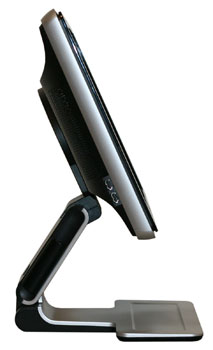 |
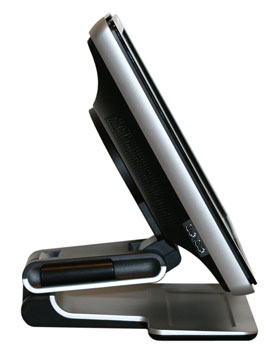 |
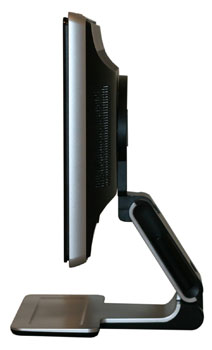 |
 |
Looking at the profile of the LCD, we see the range of motion that the base stand offers. Two USB ports are located on the left side, while the right side is empty. You can also see how the base stand extends several inches behind the back of the display.
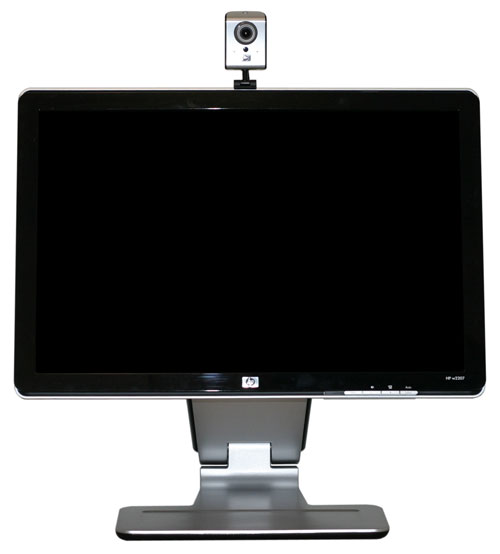 |
One of the features that HP advertises with the w2207 is their Easy Clip accessory kit that can be used to hold papers, pens, or other useful bits of information. We did not get the accessory kit with our review unit, but they did send us a webcam that attaches to the top of the display. The webcam we received is not the same model that we see shown on the online ordering pages, so we're not sure how much it actually costs. We can say that it functioned pretty much as you would expect from a webcam, and if you're the type of person that likes to use such a device the ability to easily connect it to the top of your display might make the addition worthwhile. If you don't plan on using the webcam, of course, save your pennies!










43 Comments
View All Comments
Bjoern77 - Thursday, August 2, 2007 - link
You'll find that Monitor to be very popular in Europe, specially Germany due to it's low price.Well - low price compared to other monitors.
EG, the Dell 2407 WFP HC is supposed to cost around 1000$ here, the older version is on "sale" for about 850$. If i see the US-Prices for tfts...ouch. Same goes for a lot of other monitors. The HP is the first i noticed on the us markt which seem to be on a European price level, which, i assume, is at least 25% higher.
trajan - Wednesday, August 1, 2007 - link
The one thing I immediately noticed from the review was the difference between the Gateway 24" and the Dell 24". I've never seen these ratings before -- it looks like in most catagories the Gateway is superior. Am I reading this right? I thought the Dell was the hands down 24" champion!JarredWalton - Wednesday, August 1, 2007 - link
The Gateway has a brighter backlight, but in most other areas I felt the 2407WFP and the FPD2485W were about the same. I prefer the appearance of the Dell LCD over the Gateway LCD, and the extremely bright backlight on the Gateway means that you usually have to spend more time tuning things if you don't want to be blinded. If you had them both set to the same intensity, however, I don't think most people would be able to tell the difference between the panels.nilepez - Wednesday, August 1, 2007 - link
I'm still using an old CRT, and I don't know why one would compare at a monitor with a max resolution of 1600x1050 to a CRT that was likely capable at least 1800x1440 and 1920x1440 was fairly common. Mine goes higher, but the refresh rate is too slow at that point.I personally think that the 24" displays are the first ones that are comparable to 21" monitors. The 22" monitors are more comparable to some of the better 19" monitors (though I suppose there may have been crappy 21" monitors with a max usable res of 16x12.
I personally wish I could justify the 30" monitors, but at current prices, I'd be better off going dual monitor with 2 24" models (desktop space is king :) )
Jodiuh - Wednesday, August 1, 2007 - link
Have you seen a nice 20in S-IPS next to your old CRT? I have an older 19in CRT and it pales in comparison to the NEC or Dell panels.yyrkoon - Thursday, August 2, 2007 - link
I had a professional grade 21" CRT next to my 19" WS LCD, and I have to say that the LCD is much, MUCH better for vibrance/image sharpness. The LCD to boot was also 1/5th-1/6th the cost of the 21" CRT . . .nilepez - Wednesday, August 1, 2007 - link
Probably not, given that most stores carry crappy monitors, but I'm really not willing give up real estate to move to a flat screen.even at 1920x1440, I feel cramped if I'm I've got more than 2 instances of jedit open (and I'd really like to have 4, and occasionally more, in most cases).
24" monitors are the smallest monitors with sufficient resolution, although even then, my desktop shrink by almost 20%.
Great Googly Moogly - Thursday, August 2, 2007 - link
Well, it seems you're forgetting about pixel pitch. Those 1920x1200 24" have quite a high pixel pitch. Certainly a 20.1" LCD with a 1600x1200 resolution is better for you?The only LCDs with a decent pixel pitch not stuck in 1991 (seriously) are the 1280x1024 17" (too small, physically, though), 1600x1200 20.1" and the 2560x1600 30".
The new 1920x1200 26-27" are really atrocious, and the most popular 1680x1050 22" is not up to my standards either--hence the main reason (out of many) why I'm still on an iiyama CRT. And if this trend is still going in a few years, we'll have 720p 40" computer monitors. And everyone will love them.
So sick and tired of computer display tech going steady backwards since the 90s.
jc44 - Thursday, August 2, 2007 - link
To be fair 2001 was a good year for displays - IBM built the first T221s (24" 3840x2400) :-) 2006 was not such a good year - IBM ceased production of T221s with nothing even vaguely equivalent in sight from anybody :-(strikeback03 - Thursday, August 2, 2007 - link
Didn't they cost somewhere around $30,000? no wonder they disappeared.